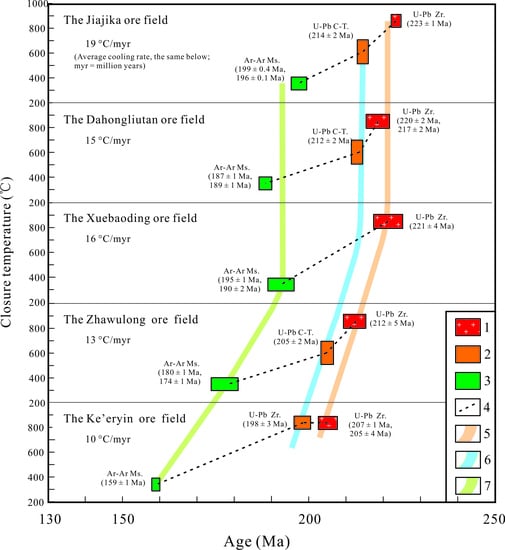Mineralization Epochs of Granitic Rare-Metal Pegmatite Deposits in the Songpan–Ganzê Orogenic Belt and Their Implications for Orogeny
Abstract
1. Introduction
2. Regional Geological Features
3. Geological Features of Major Pegmatite Deposits
3.1. Jiajika Li–Be–Ta–Nb Deposit
3.2. Dahongliutan Li–Be–Nb–Ta Deposit
3.3. Xuebaoding W–Sn–Be Deposit
3.4. Zhawulong Li–Be–Ta–Nb Deposit
3.5. Ke’eryin Li–Be–Ta–Nb Deposit
4. Sampling and Dating Methods
5. Results
5.1. Muscovite 40Ar/39Ar Dating
5.2. Zircon U–Pb Dating
5.3. Columbite–Tantalite U–Pb Dating
6. Discussion
6.1. Ages of Pegmatite Deposits in the Songpan–Ganzê Orogenic Belt
6.2. Formation Mechanism of Granite-Pegmatite Systems in the Songpan–Ganzê Orogenic Belt
6.3. Implications of Pegmatite Deposits for Orogeny in the Songpan–Ganzê Orogenic Belt
7. Conclusions
Author Contributions
Funding
Acknowledgments
Conflicts of Interest
Appendix A
| T(°C) | (40Ar/39Ar)m | (36Ar/39Ar)m | (37Ar0/39Ar)m | F | 39Ar (Cum.) (%) | Age (Ma) | ±1σ (Ma) |
|---|---|---|---|---|---|---|---|
| Dm90 muscovite W = 27.27 mg J = 0.004527 | |||||||
| 700 | 111.9480 | 0.2994 | 0.0000 | 23.4583 | 0.15 | 182.0 | 12.0 |
| 760 | 46.2993 | 0.0820 | 0.3557 | 22.1028 | 0.66 | 172.0 | 4.2 |
| 800 | 45.9735 | 0.0751 | 0.0463 | 23.7776 | 2.49 | 184.4 | 2.0 |
| 840 | 35.6290 | 0.0391 | 0.0758 | 24.0721 | 5.52 | 186.6 | 1.9 |
| 880 | 28.4870 | 0.0137 | 0.0107 | 24.4274 | 15.82 | 189.2 | 1.8 |
| 920 | 24.7410 | 0.0020 | 0.0053 | 24.1543 | 46.29 | 187.2 | 1.8 |
| 950 | 24.6020 | 0.0014 | 0.0096 | 24.1757 | 62.75 | 187.4 | 1.8 |
| 980 | 24.8512 | 0.0017 | 0.0037 | 24.33 | 70.5 | 188.5 | 1.8 |
| 1020 | 25.0782 | 0.0039 | 0.0725 | 23.9286 | 75.22 | 185.5 | 1.8 |
| 1060 | 25.0704 | 0.0037 | 0.0402 | 23.9818 | 79.92 | 185.9 | 1.8 |
| 1130 | 24.9181 | 0.0024 | 0.0161 | 24.2072 | 90.08 | 187.6 | 1.8 |
| 1200 | 24.3992 | 0.0039 | 0.0000 | 23.235 | 98.7 | 186.8 | 1.8 |
| 1400 | 26.7676 | 0.0089 | 0.0413 | 24.1321 | 100 | 187.0 | 2.3 |
| Plateau Age = 187.0 ± 1.1 Ma | |||||||
| Dm102 muscovite W = 27.05 mg J = 0.004533 | |||||||
| 700 | 114.2605 | 0.3392 | 1.3696 | 14.128 | 0.23 | 112.0 | 12.0 |
| 760 | 48.2186 | 0.0796 | 0.0000 | 24.6884 | 1.5 | 191.4 | 2.3 |
| 800 | 41.0508 | 0.0575 | 0.0183 | 24.068 | 2.95 | 186.8 | 2.2 |
| 840 | 35.1192 | 0.0365 | 0.0579 | 24.3244 | 5.93 | 188.7 | 1.9 |
| 880 | 29.2235 | 0.0151 | 0.0077 | 24.7625 | 13.62 | 191.9 | 1.8 |
| 920 | 25.2772 | 0.0030 | 0.0071 | 24.3867 | 46.81 | 189.2 | 1.8 |
| 950 | 24.9819 | 0.0016 | 0.0008 | 24.5038 | 61.11 | 190.0 | 1.8 |
| 980 | 25.3326 | 0.0021 | 0.0000 | 24.6955 | 67.12 | 191.4 | 1.8 |
| 1020 | 25.5773 | 0.0040 | 0.0148 | 24.3907 | 71.14 | 189.2 | 1.8 |
| 1060 | 25.5313 | 0.0048 | 0.0377 | 24.0993 | 75.27 | 187.0 | 1.8 |
| 1200 | 24.8587 | 0.0023 | 0.0076 | 24.1793 | 97.22 | 187.6 | 1.8 |
| 1400 | 25.6757 | 0.0041 | 0.0106 | 24.471 | 100 | 189.8 | 1.9 |
| Plateau Age = 189.4 ± 1.1 Ma | |||||||
| ZM-1 muscovite W = 15.42 mg J = 0.004750 | |||||||
| 700 | 270.8757 | 0.8839 | 0.0638 | 9.6789 | 0.30 | 81.1 | 14.7 |
| 770 | 101.9434 | 0.2777 | 0.0000 | 19.8916 | 2.22 | 162.9 | 4.2 |
| 830 | 60.9972 | 0.1296 | 0.0000 | 22.6841 | 6.24 | 184.6 | 2.0 |
| 880 | 31.1068 | 0.0293 | 0.0040 | 22.4389 | 17.07 | 182.7 | 0.5 |
| 920 | 23.4427 | 0.0047 | 0.0000 | 22.0476 | 50.97 | 179.7 | 0.3 |
| 950 | 23.4546 | 0.0050 | 0.0075 | 21.9673 | 58.43 | 179.1 | 0.4 |
| 990 | 24.2049 | 0.0069 | 0.0000 | 22.1640 | 74.37 | 180.6 | 0.3 |
| 1030 | 26.1738 | 0.0141 | 0.0000 | 21.9897 | 82.39 | 179.2 | 0.5 |
| 1080 | 26.9635 | 0.0173 | 0.0098 | 21.8437 | 90.26 | 178.1 | 0.4 |
| 1160 | 23.5498 | 0.0056 | 0.0000 | 21.8758 | 98.42 | 178.4 | 0.4 |
| 1260 | 28.1971 | 0.0211 | 0.0000 | 21.9528 | 99.76 | 179.0 | 1.0 |
| 1400 | 46.6306 | 0.0786 | 0.0000 | 23.4097 | 100.00 | 190.2 | 9.2 |
| Plateau Age = 179.6 ± 1.0 Ma | |||||||
| ZM-2 muscovite W = 16.93 mg J = 0.004779 | |||||||
| 700 | 346.3185 | 1.1314 | 0.0950 | 12.00076 | 0.35 | 100.6 | 17.9 |
| 760 | 155.2648 | 0.4345 | 0.0112 | 26.85222 | 2.00 | 217.8 | 6.3 |
| 800 | 100.0595 | 0.2638 | 0.0155 | 22.11302 | 4.12 | 181.2 | 3.9 |
| 850 | 48.3097 | 0.0902 | 0.0155 | 21.66208 | 7.48 | 177.7 | 1.4 |
| 890 | 27.3878 | 0.0199 | 0.0073 | 21.50775 | 15.81 | 176.5 | 0.4 |
| 930 | 22.6281 | 0.0050 | 0.0017 | 21.15015 | 36.06 | 173.7 | 0.3 |
| 970 | 22.4772 | 0.0042 | 0.0000 | 21.22109 | 56.45 | 174.3 | 0.3 |
| 1010 | 23.2571 | 0.0071 | 0.0000 | 21.15922 | 67.81 | 173.8 | 0.3 |
| 1060 | 25.5231 | 0.0149 | 0.0096 | 21.11696 | 76.19 | 173.5 | 0.4 |
| 1120 | 25.3077 | 0.0134 | 0.0011 | 21.32966 | 86.20 | 175.1 | 0.4 |
| 1200 | 22.8419 | 0.0056 | 0.0033 | 21.18531 | 98.81 | 174.0 | 0.3 |
| 1240 | 25.9042 | 0.0159 | 0.0000 | 21.19262 | 99.63 | 174.0 | 1.3 |
| 1280 | 36.2060 | 0.0505 | 0.0000 | 21.26801 | 99.86 | 174.6 | 3.6 |
| 1400 | 66.4398 | 0.1495 | 0.0000 | 22.24769 | 100.00 | 182.3 | 7.8 |
| Plateau Age = 174.3 ± 0.9 Ma | |||||||
| Km1 muscovite W = 46.00 mg J = 0.011771 | |||||||
| 500 | 35.5959 | 0.0953 | 0.1089 | 7.4408 | 0.24 | 151 | 12 |
| 600 | 18.4300 | 0.0362 | 0.1884 | 7.7409 | 0.37 | 157.3 | 6.6 |
| 700 | 26.6486 | 0.0695 | 0.0635 | 6.1205 | 0.73 | 126 | 11 |
| 800 | 19.9345 | 0.0458 | 0.0276 | 6.4044 | 1.26 | 131.1 | 5.8 |
| 900 | 11.1333 | 0.0120 | 0.0164 | 7.5871 | 3.17 | 154.3 | 1.5 |
| 1000 | 9.7808 | 0.0065 | 0.0104 | 7.8681 | 11.46 | 159.8 | 1.6 |
| 1050 | 8.3920 | 0.0021 | 0.0016 | 7.7543 | 35.48 | 157.6 | 1.6 |
| 1100 | 8.0570 | 0.0012 | 0.0017 | 7.698 | 54.53 | 156.5 | 1.6 |
| 1200 | 8.2419 | 0.0019 | 0.0022 | 7.6761 | 65.35 | 156.1 | 1.5 |
| 1300 | 8.0557 | 0.0011 | 0.0012 | 7.718 | 88.86 | 156.9 | 1.6 |
| 1400 | 8.0256 | 0.0007 | 0.0018 | 7.8019 | 100 | 158.5 | 1.5 |
| Plateau Age = 159.0 ± 1.4 Ma | |||||||
| Grain Spot | Th | U | Th/U | Isotopic Ratios | Age(Ma) | ||||||||||
|---|---|---|---|---|---|---|---|---|---|---|---|---|---|---|---|
| 207Pb/ | 1σ | 207Pb/ | 1σ | 206Pb/ | 1σ | 207Pb/ | 1σ | 207Pb/ | 1σ | 206Pb/ | 1σ | ||||
| 206Pb | 235U | 238U | 206Pb | 235U | 238U | ||||||||||
| ZG-1-1 | 222.2 | 2227.0 | 0.10 | 0.0519 | 0.0013 | 0.2517 | 0.0071 | 0.0335 | 0.0016 | 282.1 | 55.4 | 227.9 | 5.7 | 212.4 | 9.7 |
| ZG-1-2 | 62.0 | 1114.6 | 0.06 | 0.0499 | 0.0011 | 0.2335 | 0.0057 | 0.0337 | 0.0016 | 189.8 | 49.2 | 213.1 | 4.7 | 213.6 | 9.7 |
| ZG-1-3 | 200.8 | 367.0 | 0.55 | 0.0603 | 0.0016 | 0.7674 | 0.0281 | 0.0939 | 0.0044 | 613.8 | 56.8 | 578.3 | 16.2 | 578.8 | 25.8 |
| ZG-1-4 | 77.7 | 675.4 | 0.12 | 0.0521 | 0.0015 | 0.2340 | 0.0075 | 0.0333 | 0.0016 | 291.1 | 64.5 | 213.5 | 6.2 | 211.1 | 9.7 |
| ZG-1-5 | 83.5 | 695.9 | 0.12 | 0.0500 | 0.0014 | 0.2371 | 0.0074 | 0.0336 | 0.0016 | 194.5 | 63.1 | 216.1 | 6.0 | 212.8 | 9.8 |
| ZG-1-6 | 58.3 | 551.4 | 0.11 | 0.0540 | 0.0032 | 0.2382 | 0.0159 | 0.0321 | 0.0016 | 370.5 | 129.6 | 216.9 | 13.1 | 203.9 | 9.9 |
| ZG-1-7 | 165.0 | 398.6 | 0.41 | 0.0541 | 0.0018 | 0.4951 | 0.0211 | 0.0643 | 0.0030 | 376.9 | 74.7 | 408.3 | 14.4 | 402.0 | 18.4 |
| ZG-1-8 | 88.7 | 2027.5 | 0.04 | 0.0528 | 0.0011 | 0.2360 | 0.0055 | 0.0328 | 0.0015 | 321.9 | 46.1 | 215.1 | 4.5 | 207.9 | 9.5 |
| ZG-1-9 | 282.6 | 1527.5 | 0.19 | 0.0501 | 0.0011 | 0.2369 | 0.0058 | 0.0338 | 0.0016 | 198.8 | 49.1 | 215.8 | 4.7 | 214.1 | 9.8 |
| ZG-1-10 | 1026.9 | 1457.4 | 0.70 | 0.0511 | 0.0019 | 0.2321 | 0.0097 | 0.0323 | 0.0015 | 245.7 | 83.3 | 211.9 | 8.0 | 205.2 | 9.6 |
| ZG-1-11 | 2448.1 | 770.5 | 3.18 | 0.0516 | 0.0017 | 0.2364 | 0.0088 | 0.0333 | 0.0016 | 266.3 | 74.7 | 215.4 | 7.2 | 211.2 | 9.8 |
| ZG-1-12 | 201.1 | 427.5 | 0.47 | 0.0710 | 0.0011 | 1.4007 | 0.0329 | 0.1473 | 0.0068 | 956.6 | 32.3 | 889.2 | 13.9 | 885.6 | 38.4 |
| ZG-1-13 | 912.5 | 12605.2 | 0.07 | 0.4446 | 0.0050 | 1.4477 | 0.0193 | 0.0300 | 0.0014 | 4067.3 | 16.6 | 908.9 | 8.0 | 190.5 | 8.7 |
| ZG-1-14 | 156.6 | 165.8 | 0.94 | 0.0591 | 0.0023 | 0.5613 | 0.0271 | 0.0737 | 0.0035 | 570.9 | 81.1 | 452.4 | 17.6 | 458.6 | 21.1 |
| ZG-1-15 | 53.3 | 644.8 | 0.08 | 0.0521 | 0.0016 | 0.2370 | 0.0081 | 0.0341 | 0.0016 | 290.7 | 68.5 | 215.9 | 6.7 | 215.9 | 10.0 |
| ZG-1-16 | 70.7 | 258.8 | 0.27 | 0.0622 | 0.0019 | 0.7667 | 0.0326 | 0.0913 | 0.0043 | 682.5 | 65.3 | 577.8 | 18.8 | 563.0 | 25.5 |
| ZG-1-17 | 55.0 | 623.6 | 0.09 | 0.0529 | 0.0025 | 0.2412 | 0.0125 | 0.0340 | 0.0016 | 325.0 | 102.1 | 219.4 | 10.2 | 215.5 | 10.2 |
| ZG-1-18 | 116.7 | 250.8 | 0.47 | 0.1845 | 0.0025 | 10.1794 | 0.3342 | 0.3985 | 0.0186 | 2694.0 | 22.5 | 2451.2 | 30.4 | 2162.1 | 85.7 |
| ZG-1-19 | 677.1 | 655.7 | 1.03 | 0.0650 | 0.0014 | 0.9601 | 0.0299 | 0.1075 | 0.0050 | 773.0 | 45.4 | 683.4 | 15.5 | 658.0 | 29.3 |
| ZG-1-20 | 321.4 | 174.0 | 1.85 | 0.0595 | 0.0020 | 0.7615 | 0.0351 | 0.0925 | 0.0044 | 584.7 | 72.3 | 574.9 | 20.2 | 570.1 | 25.9 |
| ZG-1-21 | 405.4 | 837.8 | 0.48 | 0.0543 | 0.0010 | 0.4983 | 0.0118 | 0.0650 | 0.0030 | 381.9 | 42.7 | 410.6 | 8.0 | 405.8 | 18.4 |
| ZG-1-22 | 17.4 | 1873.8 | 0.01 | 0.0519 | 0.0023 | 0.2419 | 0.0122 | 0.0331 | 0.0016 | 280.1 | 99.2 | 220.0 | 10.0 | 209.6 | 10.0 |
| ZG-1-23 | 32.1 | 792.4 | 0.04 | 0.0520 | 0.0018 | 0.2410 | 0.0096 | 0.0332 | 0.0016 | 286.1 | 78.8 | 219.2 | 7.8 | 210.3 | 9.8 |
| ZG-1-24 | 92.7 | 1029.7 | 0.09 | 0.1130 | 0.0040 | 0.4594 | 0.0194 | 0.0277 | 0.0014 | 1847.9 | 62.9 | 383.8 | 13.5 | 176.4 | 8.5 |
| ZG-1-25 | 520.7 | 339.9 | 1.53 | 0.1019 | 0.0034 | 0.5545 | 0.0227 | 0.0392 | 0.0019 | 1658.6 | 60.2 | 447.9 | 14.8 | 248.1 | 11.7 |
| ZG-1-26 | 248.6 | 2164.3 | 0.11 | 0.0502 | 0.0011 | 0.2346 | 0.0056 | 0.0344 | 0.0016 | 204.3 | 48.4 | 214.0 | 4.6 | 217.7 | 10.1 |
| ZG-1-27 | 504.3 | 1015.3 | 0.50 | 0.0739 | 0.0015 | 0.7688 | 0.0207 | 0.0713 | 0.0034 | 1039.7 | 40.3 | 579.0 | 11.9 | 444.2 | 20.2 |
| ZG-1-28 | 8.1 | 854.3 | 0.01 | 0.0618 | 0.0021 | 0.2416 | 0.0090 | 0.0332 | 0.0016 | 668.0 | 70.2 | 219.8 | 7.4 | 210.3 | 9.9 |
| Zct-1-1 | 0.4 | 56.3 | 0.01 | 0.0705 | 0.0010 | 0.3386 | 0.0066 | 0.0349 | 0.0006 | 941.9 | 29.7 | 296.1 | 5.0 | 221.0 | 3.6 |
| Zct-1-2 | 0.4 | 60.5 | 0.01 | 0.0665 | 0.0010 | 0.3214 | 0.0062 | 0.0351 | 0.0006 | 822.9 | 30.2 | 282.9 | 4.8 | 222.1 | 3.7 |
| Zct-1-3 | 1.9 | 196.5 | 0.01 | 0.0556 | 0.0007 | 0.2431 | 0.0043 | 0.0317 | 0.0005 | 435.6 | 26.2 | 221.0 | 3.5 | 201.5 | 3.3 |
| Zct-1-4 | 845.4 | 733.0 | 1.15 | 0.4460 | 0.0044 | 116.9998 | 1.9078 | 1.9041 | 0.0314 | 4071.9 | 14.7 | 4844.1 | 16.4 | 6872.7 | 69.8 |
| Zct-1-5 | 2.2 | 149.0 | 0.01 | 0.0974 | 0.0011 | 0.5194 | 0.0089 | 0.0387 | 0.0006 | 1574.1 | 21.0 | 424.7 | 5.9 | 244.9 | 4.0 |
| Zct-1-6 | 0.6 | 71.7 | 0.01 | 0.0847 | 0.0011 | 0.3986 | 0.0073 | 0.0342 | 0.0006 | 1308.7 | 25.6 | 340.6 | 5.3 | 216.5 | 3.6 |
| Zct-1-7 | 1.3 | 126.1 | 0.01 | 0.0559 | 0.0007 | 0.2452 | 0.0045 | 0.0318 | 0.0005 | 449.5 | 28.3 | 222.6 | 3.7 | 201.9 | 3.3 |
| Zct-1-8 | 1.1 | 106.4 | 0.01 | 0.0644 | 0.0008 | 0.3138 | 0.0057 | 0.0354 | 0.0006 | 755.6 | 26.8 | 277.1 | 4.4 | 224.0 | 3.7 |
| Zct-1-9 | 0.8 | 86.8 | 0.01 | 0.0569 | 0.0008 | 0.2502 | 0.0048 | 0.0319 | 0.0005 | 488.5 | 31.3 | 226.7 | 3.9 | 202.4 | 3.3 |
| Zct-1-10 | 1.0 | 114.8 | 0.01 | 0.0536 | 0.0007 | 0.2372 | 0.0044 | 0.0321 | 0.0005 | 354.0 | 30.0 | 216.1 | 3.6 | 203.8 | 3.3 |
| Zct-1-11 | 0.3 | 51.4 | 0.01 | 0.0726 | 0.0011 | 0.3388 | 0.0066 | 0.0339 | 0.0006 | 1003.9 | 29.9 | 296.3 | 5.0 | 214.6 | 3.5 |
| Zct-1-12 | 0.2 | 30.9 | 0.01 | 0.0652 | 0.0011 | 0.3219 | 0.0069 | 0.0358 | 0.0006 | 781.6 | 36.1 | 283.3 | 5.3 | 226.9 | 3.8 |
| Zct-1-13 | 4.5 | 295.4 | 0.02 | 0.0562 | 0.0006 | 0.2484 | 0.0043 | 0.0321 | 0.0005 | 460.5 | 25.3 | 225.3 | 3.5 | 203.5 | 3.3 |
| Zct-1-14 | 1.3 | 110.5 | 0.01 | 0.0553 | 0.0008 | 0.2430 | 0.0046 | 0.0319 | 0.0005 | 425.9 | 30.6 | 220.9 | 3.8 | 202.2 | 3.3 |
| Zct-1-15 | 0.6 | 71.8 | 0.01 | 0.0667 | 0.0009 | 0.3306 | 0.0062 | 0.0360 | 0.0006 | 826.7 | 28.6 | 290.0 | 4.7 | 228.0 | 3.7 |
| Zct-1-16 | 2.0 | 129.8 | 0.02 | 0.1922 | 0.0021 | 1.0484 | 0.0176 | 0.0396 | 0.0007 | 2760.8 | 17.5 | 728.1 | 8.7 | 250.4 | 4.1 |
| Zct-1-17 | 0.7 | 130.6 | 0.01 | 0.0593 | 0.0008 | 0.2719 | 0.0049 | 0.0333 | 0.0006 | 576.4 | 27.2 | 244.2 | 3.9 | 211.2 | 3.5 |
| Zct-1-18 | 0.6 | 69.0 | 0.01 | 0.0720 | 0.0010 | 0.3706 | 0.0069 | 0.0374 | 0.0006 | 985.3 | 27.5 | 320.1 | 5.1 | 236.5 | 3.9 |
| Zct-1-19 | 0.9 | 101.9 | 0.01 | 0.0543 | 0.0008 | 0.2350 | 0.0045 | 0.0314 | 0.0005 | 382.7 | 32.0 | 214.3 | 3.7 | 199.4 | 3.3 |
| Zct-1-20 | 0.7 | 125.7 | 0.01 | 0.0618 | 0.0008 | 0.2876 | 0.0052 | 0.0338 | 0.0006 | 668.0 | 26.7 | 256.6 | 4.1 | 214.0 | 3.5 |
| Zct-1-21 | 1.2 | 103.7 | 0.01 | 0.0577 | 0.0008 | 0.2823 | 0.0051 | 0.0355 | 0.0006 | 519.5 | 28.4 | 252.5 | 4.1 | 224.8 | 3.7 |
| Zct-1-22 | 0.8 | 87.7 | 0.01 | 0.0552 | 0.0008 | 0.2544 | 0.0048 | 0.0335 | 0.0006 | 418.6 | 30.6 | 230.1 | 3.9 | 212.2 | 3.5 |
| Zct-1-23 | 1.1 | 119.8 | 0.01 | 0.0536 | 0.0007 | 0.2438 | 0.0045 | 0.0330 | 0.0006 | 353.6 | 29.2 | 221.5 | 3.6 | 209.4 | 3.4 |
| Zct-1-24 | 0.0 | 100.2 | 0.00 | 0.0687 | 0.0009 | 0.3198 | 0.0058 | 0.0338 | 0.0006 | 890.0 | 26.5 | 281.8 | 4.5 | 214.2 | 3.5 |
| Zct-1-25 | 1.6 | 160.9 | 0.01 | 0.0525 | 0.0007 | 0.2328 | 0.0042 | 0.0322 | 0.0005 | 307.8 | 28.1 | 212.5 | 3.4 | 204.2 | 3.3 |
| Zct-1-26 | 1.9 | 179.5 | 0.01 | 0.0528 | 0.0006 | 0.2356 | 0.0042 | 0.0324 | 0.0005 | 319.7 | 27.3 | 214.8 | 3.4 | 205.5 | 3.4 |
| Zct-1-27 | 0.5 | 72.8 | 0.01 | 0.0653 | 0.0009 | 0.3254 | 0.0061 | 0.0362 | 0.0006 | 783.4 | 28.6 | 286.1 | 4.7 | 229.1 | 3.8 |
| Zct-1-28 | 0.0 | 105.7 | 0.00 | 0.0692 | 0.0009 | 0.3187 | 0.0058 | 0.0335 | 0.0006 | 903.3 | 26.3 | 280.9 | 4.5 | 212.1 | 3.5 |
| Zct-1-29 | 0.5 | 69.5 | 0.01 | 0.0621 | 0.0009 | 0.2753 | 0.0053 | 0.0322 | 0.0005 | 675.7 | 31.1 | 246.9 | 4.3 | 204.3 | 3.4 |
| Zct-1-30 | 0.9 | 97.1 | 0.01 | 0.0551 | 0.0008 | 0.2432 | 0.0046 | 0.0321 | 0.0005 | 414.0 | 30.1 | 221.0 | 3.7 | 203.4 | 3.3 |
| Zct-1-31 | 0.9 | 125.8 | 0.01 | 0.0560 | 0.0007 | 0.2445 | 0.0045 | 0.0317 | 0.0005 | 450.0 | 28.4 | 222.1 | 3.7 | 201.3 | 3.3 |
| Zct-1-32 | 0.9 | 89.0 | 0.01 | 0.0589 | 0.0009 | 0.2501 | 0.0050 | 0.0308 | 0.0005 | 561.9 | 33.0 | 226.7 | 4.1 | 195.8 | 3.2 |
| Zct-1-33 | 0.8 | 75.4 | 0.01 | 0.0631 | 0.0009 | 0.2780 | 0.0054 | 0.0320 | 0.0005 | 710.7 | 30.8 | 249.1 | 4.3 | 203.0 | 3.3 |
| Zct-1-34 | 0.7 | 63.4 | 0.01 | 0.0594 | 0.0009 | 0.2727 | 0.0055 | 0.0333 | 0.0006 | 580.6 | 33.5 | 244.8 | 4.4 | 211.4 | 3.5 |
| Zct-1-35 | 1.2 | 125.8 | 0.01 | 0.0536 | 0.0007 | 0.2412 | 0.0044 | 0.0327 | 0.0005 | 352.6 | 29.1 | 219.4 | 3.6 | 207.3 | 3.4 |
| Zct-1-36 | 1.9 | 182.9 | 0.01 | 0.0638 | 0.0008 | 0.3119 | 0.0055 | 0.0355 | 0.0006 | 734.1 | 24.9 | 275.7 | 4.2 | 224.9 | 3.7 |
| Zct-1-37 | 0.7 | 85.8 | 0.01 | 0.0555 | 0.0008 | 0.2479 | 0.0048 | 0.0324 | 0.0005 | 431.9 | 31.4 | 224.9 | 3.9 | 205.7 | 3.4 |
| Zct-1-38 | 0.9 | 88.8 | 0.01 | 0.0538 | 0.0008 | 0.2403 | 0.0046 | 0.0324 | 0.0005 | 364.3 | 31.6 | 218.6 | 3.7 | 205.5 | 3.4 |
| Zct-1-39 | 0.5 | 63.1 | 0.01 | 0.0632 | 0.0009 | 0.2956 | 0.0058 | 0.0340 | 0.0006 | 714.9 | 31.4 | 263.0 | 4.5 | 215.2 | 3.5 |
| Zct-1-40 | 0.9 | 100.2 | 0.01 | 0.0555 | 0.0008 | 0.2750 | 0.0051 | 0.0360 | 0.0006 | 431.1 | 29.3 | 246.7 | 4.1 | 227.9 | 3.7 |
References
- Černý, P. Rare-element granite pegmatites: Part II. Regional to global environments and petrogenesis. Geosci. Can. 1991, 18, 68–81. [Google Scholar]
- Linnen, R.L.; Lichtervelde, M.V.; Černý, P. Granitic pegmatites as sources of strategic metals. Elements 2012, 8, 275–280. [Google Scholar] [CrossRef]
- Ginsburg, A.I.; Timofeev, I.N.; Feldman, L.G. Osnovy Geologii Granitnykh Pegmatitov (Principles of Geology of Granitic Pegmatites); Nedra: Moscow, Russia, 1979. (In Russian) [Google Scholar]
- McCauley, A.; Bradley, D.C. Global age distribution of granitic pegmatites. Can. Mineral. 2014, 52, 18–190. [Google Scholar] [CrossRef]
- Tkachev, A.V.; Rundqvist, D.V.; Vishnevskaya, N.A. Comparison of Supercontinent Cycles in the Metallogeny of Rare Earth Elements. Dokl. Earth Sci. 2018, 480, 730–734. [Google Scholar] [CrossRef]
- Tkachev, A.V. Evolution of Metallogeny of Granitic Pegmatites Associated with Orogens Throughout Geological Time; Geological Society Special Publication: London, UK, 2011; Volume 350, pp. 7–24. [Google Scholar]
- Pedrosa, A.C.; Lobato, L.M.; Noce, C.M. Cambrian pegmatitic and hydrothermal mineral deposits: The last mineralization record prior to the south Atlantic opening in eastern Brazil. In Proceedings of the 31st Internal Geological Congress, Rio de Janeiro, Brazil, 6–17 August 2000; Volume 1. [Google Scholar]
- Galetskiy, L.S. Perga beryllium deposit of the Ukranian shield as the geological phenomena. In Proceedings of the 31st Internal Geological Congress, Rio de Janeiro, Brazil, 6–17 August 2000; Volume 1. [Google Scholar]
- Mints, M.V. Paleoproterozoic tectonic evolution and related metallogeny of the Eastern Baltic shield and Voronezh crystalline massif of the east European craton. In Proceedings of the 31st Internal Geological Congress, Rio de Janeiro, Brazil, 6–17 August 2000; Volume 1. [Google Scholar]
- Mohammedyasin, M.S.; Desta, Z.; Getaneh, W. Petrography and geochemistry of the primary ore zone of the Kenticha rare metal granite-pegmatite field, Adola Belt, Southern Ethiopia: Implications for ore genesis and tectonic setting. J. Afr. Earth Sci. 2017, 134, 73–84. [Google Scholar] [CrossRef]
- Makrygina, V.A.; Suvorova, L.F.; Antipin, V.S.; Makagon, V.M. Rare-metal pegmatoid granites, markers of the beginning of the Hercynian within-plate stage in the Ol’khon region of the Baikal area. Russ. Geol. Geophys. 2018, 59, 1626–1639. [Google Scholar] [CrossRef]
- Li, J.; Zou, T.; Liu, X.; Wang, D.; Ding, X. The Metallogenetic Regularities of Lithium Deposits in China. Acta Geol. Sin. 2015, 89, 652–670, (In Chinese with English abstract). [Google Scholar]
- Roger, F.; Malavieille, J.; Leloup, P.H.; Calassou, S.; Xu, Z. Timing of granite emplacement and cooling in the Songpan-Garze fold belt (eastern Tibetan Plateau) with tectonic implications. J. Asian Earth Sci. 2004, 22, 465–481. [Google Scholar] [CrossRef]
- Harrowfield, M.J.; Wilson, C.J. Indosinian deformation of the Songpan Garze Fold Belt, northeast Tibetan Plateau. J. Struct. Geol. 2005, 27, 101–117. [Google Scholar] [CrossRef]
- Xu, Z.; Wang, R.; Zhao, Z.; Fu, X. On the structural back grounds of the large-scale “hard-rock type”lithium ore belts in China. Acta Geol. Sin. 2018, 92, 1091–1106, (In Chinese with English abstract). [Google Scholar]
- Hao, X.; Fu, X.; Liang, B.; Yuan, Y.; Pan, M.; Tang, Y. Formation ages of granite and X03 pegmatite vein in Jiajika, western Sichuan, and their geological significance. Miner. Depos. 2015, 34, 1199–1208, (In Chinese with English abstract). [Google Scholar]
- Wang, D.; Li, J.; Fu, X. 40Ar/39Ar dating for the Jiajika pegmatite-type rare metal deposit in western Sichuan and its significance. Geochimica 2005, 34, 541–547, (In Chinese with English abstract). [Google Scholar]
- Zhang, H.; Zhang, L.; Harris, N.; Jin, L.; Yuan, H. U–Pb zircon ages, geochemical and isotopic compositions of granitoids in Songpan–Garze fold belt, eastern Tibetan Plateau: Constraints on petrogenesis and tectonic evolution of the basement. Contrib. Miner. Petrol. 2006, 152, 75–88. [Google Scholar] [CrossRef]
- Zhang, D.; Peng, J.; Coulson, I.; H, L.; Li, S. Cassiterite U–Pb and muscovite 40Ar–39Ar age constraints on the timing of mineralization in the Xuebaoding Sn–W–Be deposit, western China. Ore Geol. Rev. 2014, 62, 315–322. [Google Scholar] [CrossRef]
- Chen, S.F.; Wilson, C.J. Emplacement of the Longmen Shan Thrust-Nappe Belt along the eastern margin of the Tibetan Plateau. J. Struct. Geol. 1996, 18, 413–440. [Google Scholar] [CrossRef]
- Liu, Z.; Pei, X.; Li, R.; Li, Z.; Zhang, X.; Liu, Z.; Chen, G.; Chen, Y.; Ding, S.; Guo, J. LA-ICP-MS zircon U–Pb geochronology of the two suites of ophiolites atthe Buqingshan area of the Acnyemaqen Orogenic Belt in the Southern Marginof East Kunlun and its tectonic implication. Acta Geol. Sin. 2011, 85, 185–195, (In Chinese with English abstract). [Google Scholar]
- Qiu, D.Z.; Xie, Y.; Zhao, Z.; Rong, L.; Yang, P.; Zhang, D. An analysis of the oil and gas system in the reformed basin: a case study of the basin-mountain transitional area on the western side of the Xuefeng Mountain. Geol. Bull. China 2012, 31, 1781–1794, (In Chinese with English abstract). [Google Scholar]
- Zou, T.; Li, Q. Rare and Rare Earth Metallic Deposit in Xinjiang, China; Geological Publishing House: Beijing, China, 2005; pp. 1–284. (In Chinese) [Google Scholar]
- Li, J.; Fu, X.; Zou, T.; Wang, D. Prospecting breakthrough of and outside prospecting prospect analysis of Jiajika lithium deposit. Miner. Depos. 2014, 33, 1175–1176, (In Chinese with English abstract). [Google Scholar]
- Wang, D.; Liu, L.; Dai, H.; Liu, S.; Hou, J.; Wu, X. Discussion on particularity and prospecting direction of large and Super-large spodumene deposits. Earth Sci. 2017, 42, 2243–2257, (In Chinese with English abstract). [Google Scholar]
- Wang, H.; Li, P.; Ma, H.; Zhu, B.; Qiu, L.; Zhang, X.; Dong, R.; Zhou, K.; Wang, M.; Wang, Q.; et al. Discovery of the Bailongshan superlarge lithium-rubidium deposit in Karakorum, Hetian, Xinjiang, and its prospecting implication. Geotecton. Metallog. 2017, 41, 1053–1062, (In Chinese with English abstract). [Google Scholar]
- Li, J.; Wang, D.; Zhang, D.; Fu, X. Mineralizing Mechanism and Continental Geodynamics of Typical Pegmatite Deposits in Western Sichuan, China; Atomic Energy Press: Beijing, China, 2007; p. 187, (In Chinese with English abstract). [Google Scholar]
- Li, X.; Li, J.; Liu, Y.; Xiong, C. Geochemical features of muscovite granite in the Zhawulong granitic pegmatite type rare metal deposit, western Sichuan. Geol. Rev. 2018, 64, 231–242. [Google Scholar]
- Cao, Z.; Zheng, J.; Li, Y.; Ren, J.; Xu, S.; Wang, R. The Ore fluid and its tracing and dating in the Xuebaoding beryl-scheelite vein deposit, China. Sci. China 2002, 45, 719–729. [Google Scholar]
- Li, J.; Wang, D.; Fu, X. 40Ar/39Ar Ages of the Ke’eryin pegmatite type rare metal deposit, western Sichuan, and its tectonic Significances. Acta Geol. Sin. 2006, 80, 843–848, (In Chinese with English abstract). [Google Scholar]
- Wang, S.; Sang, H.; Hu, S.; Qiu, J. 40Ar–39Ar age determination using 49-2 reactor and 40Ar–39Ar age spectrum for amphibolite for Qiannan, China. Acta Petrol. Sin. 1985, 2, 35–44, (In Chinese with English abstract). [Google Scholar]
- Chen, W.; Zhang, Y.; Ji, Q. The magmatism and deformation times of the Xidatan rock series, East Kunlun Mountain. Sci. China 2002, 45, 20–27. [Google Scholar] [CrossRef]
- Liu, Y.; Zhang, R.Q.; Zhang, Z.Y.; Shi, G.H.; Zhang, Q.C.; Abuduwayiti, M.; Liu, J.H. Mineral inclusions and SHRIMP U–Pb dating of zircons from the Alamas nephrite and granodiorite: implications for the genesis of a magnesian skarn deposit. Lithos 2015, 212–215, 128–144. [Google Scholar] [CrossRef]
- Liu, Y.S.; Gao, S.; Hu, Z.C.; Gao, C.G.; Zong, K.Q.; Wang, D.B. Continental and oceanic crust recycling-induced melt–peridotite interactions in the Trans-North China Orogen: U–Pb dating, Hf isotopes and trace elements in zircons from mantle xenoliths. J. Petrol. 2010, 51, 537–571. [Google Scholar] [CrossRef]
- Anderson, T. Correction of common lead in U–Pb analyses that do not report 204Pb. Chem. Geol. 2002, 192, 59–79. [Google Scholar] [CrossRef]
- Elhlou, S.; Belousova, E.; Griffin, W.L.; Pearson, N.J.; O’ Reilly, S.Y. Trace element and isotopic composition of GJ–red zircon standard by laser ablation. Geochim. Cosmochim. Acta 2006, 70, A158. [Google Scholar] [CrossRef]
- Sláma, J.; Kosler, J.; Condon, D.J.; Crowley, J.L.; Gerdes, A.; Hanchar, J.M.; Horstwood, M.S.; Morris, G.A.; Nasdala, L.; Norberg, N.; et al. Plesovice zircon—A new natural reference material for U–Pb and Hf isotopic microanalysis. Chem. Geol. 2008, 249, 1–35. [Google Scholar] [CrossRef]
- Che, X.D.; Wu, F.Y.; Wang, R.C.; Gerdes, A.; Ji, W.Q.; Zhao, Z.H. In situ U–Pb isotopic dating of columbite-tantalite by LA-ICP-MS. Ore Geol. Rev. 2015, 65, 979–989. [Google Scholar] [CrossRef]
- Nier, A.O. A redetermination of the relative abundances of the isotope of carbon, nitro, oxygen, argon and potassium. Physics 1950, 77, 789–793. [Google Scholar]
- Liati, A.; Gebauer, D. Constraining the prograde and retrograde P-T-t path of Eocene HP rocks by SHRIMP dating of different zircon domains: inferred rates of heating, burial, cooling and exhumation for central Rhodope, northern Greece. Contrib. Mineral. Petrol. 1999, 135, 340–354. [Google Scholar] [CrossRef]
- Rubatto, D.; Liati, A.; Gebauer, D. Dating UHP metamorphism. In Ultra-high Pressure Metamorphism; Compagnoni, R., Carswell, D.A., Eds.; European Mineralogical Union: Budapest, Hungary, 2003; Volume 5, pp. 341–363. [Google Scholar]
- DeWitt, E.D.; Armstrong, R.L.; Sutter, J.F.; Zartman, R.E. U–Th–Pb, Rb–Sr, and Ar–Ar mineral and whole-rock isotopic systematics in a metamorphosed granitic terrane, southeastern California. Geology 1984, 95, 723–739. [Google Scholar] [CrossRef]
- Mezger, K. Geochronology in granulites. In Granulites and Crustal Evolution; Vielzeuf, D., Vidal, P., Eds.; Kluwer: Amsterdam, The Netherlands, 1990; pp. 451–470. [Google Scholar]
- Lee, J.K.; Williams, I.S.; Ellis, D.J. Pb, U and Th diffusion innatural zircon. Nature 1997, 390, 159–161. [Google Scholar] [CrossRef]
- Dahl, P.S. A crystal–chemical basis for Pb retention and fission–trackannealing systematics in U-bearing minerals, with implications for geochronology. Earth Planet. Sci. Lett. 1997, 150, 277–290. [Google Scholar] [CrossRef]
- McLelland, J.; Hamilton, M.; Selleck, B. Zircon U–Pb geochronology of the Ottawan Orogeny, Adirondack Highlands, New York: Regional and tectonic implications. Precambrian Res. 2001, 109, 39–72. [Google Scholar] [CrossRef]
- Qiao, G.; Zhang, H.; Wu, Y.; Jin, M.; Du, W.; Zhao, X. Petrogenesis of the Dahongliutan monzogranite in western Kunlun: Constraints from SHRIMP zircon U–Pb geochronology and geochemical characteris. Acta Geol. Sin. 2015, 89, 1180–1194, (In Chinese with English abstract). [Google Scholar]
- Yan, Q.H.; Qiu, Z.W.; Wang, H.; Wang, M.; Wei, X.P.; Li, P.; Zhang, R.Q.; Li, C.Y.; Liu, J.P. Age of the Dahongliutan rare metal pegmatite deposit, West Kunlun, Xinjiang (NW China): Constraints from LA–ICP–MS U–Pb dating of columbite-(Fe) and cassiterite. Ore Geol. Rev. 2018, 100, 561–573. [Google Scholar] [CrossRef]
- Zhao, Z.; Du, X.J.; Liang, F.H.; Wu, C.; Liu, X.J. Structure and metamorphism of markam gneiss dome from the eastern Tibetan plateau and its implications for crustal thickening, metamorphism, and exhumation. Geochem. Geophys. Geosystems 2018, 20, 24–45. [Google Scholar] [CrossRef]
- Yue, X.; Guo, J.; Mao, S.; Zhu, Z.; Tan, H. Zircon U–Pb age and geochemistry of the Taiyanghe granitoid in western Sichuan, China and its geological significance. Bull. Mineral. Petrol. Geochem. 2018, 37, 1142–1151, (In Chinese with English abstract). [Google Scholar]
- Fei, G.; Tian, J.; Yang, J.; Gao, J.; Tang, W.; Li, J.; Gu, C. New Zircon U–Pb Age of the Super–Large Lijiagou Spodumene Deposit in Songpan–Ganzê Fold Belt, Eastern Tibet: Implications for Early Jurassic Rare-Metal Polymetallic Event. Acta Geol. Sin. 2018, 92, 1274–1275. [Google Scholar] [CrossRef]
- Harrison, T.M.; Duncan, I.; McDougall, I. Diffusion of Ar in biotite: Temperature, pressure and compositional effects. Geochim. Cosmochim. Acta 1985, 49, 2461–2468. [Google Scholar] [CrossRef]
- Dodson, M.H.; MeClelland-Brown, E. Isotopic and palaeomagnetic evidence for rates of cooling, uplift and erosion. In The Chronology of Geological Record; Snelling, N.J., Ed.; Geological Society Memory: London, UK, 1985; pp. 315–325. [Google Scholar]
- London, D. Pegmatites. Spec. Publ. Can. Mineral. 2008, 10, 1–347. [Google Scholar]
- Sirbescu, M.; Nabelek, P. Crustal melts below 400 °C. Geology 2003, 31, 685–688. [Google Scholar] [CrossRef]
- Li, J.; Chou, I.M. Homogenization experiments of crystal-rich inclusions in spodumene from Jiajika lithium deposit, China, under elevated external pressures in a hydrothermal diamond-anvil cell. Geofluids 2017, 2017. [Google Scholar] [CrossRef]
- Patiño Douce, A.E.; Harris, N. Experimental constraints on Himalayan Anatexis. J. Petrol. 1998, 39, 689–710. [Google Scholar] [CrossRef]
- Chappell, B.W.; White, A.J. Two contrasting granite types: 25 years later. J. Geol. Soc. Aust. 2001, 48, 489–499. [Google Scholar] [CrossRef]
- Martin, R.F.; De Vito, C. The patterns of enrichment in felsic pegmatites ultimately depend on tectonic setting. Can. Mineral. 2005, 43, 2027–2048. [Google Scholar] [CrossRef]
- Černý, P.; London, D.; Novák, M. Granitic pegmatites as reflections of their sources. Elements 2012, 8, 289–294. [Google Scholar] [CrossRef]
- Park, R.G. The Lewisian terrane model: A review. J. Geol. Soc. 2005, 41, 105–118. [Google Scholar] [CrossRef]
- Goodenough, K.M.; Crowley, Q.G.; Krabbendam, M.; Parry, S.F. New U–Pb age constraints for the Laxford Shear Zone, NW Scotland: Evidence for tectonomagmatic processes associated with the formation of a Palaeoproterozoic supercontinent. Precambrian Res. 2013, 233, 1–19. [Google Scholar] [CrossRef]
- Mason, A.J. The Palaeoproterozoic anatomy of the Lewisian Complex, NW Scotland: Evidence for two ‘Laxfordian’ tectonothermal cycles. J. Geol. Soc. 2015, 173, 153–169. [Google Scholar] [CrossRef]
- Bea, F.; Pereira, M.D.; Stroh, A. Mineral/leucosome trace-element partitioning in a peraluminous migmatite (a laser ablation-ICP-MS study). Chem. Geol. 1994, 117, 291–312. [Google Scholar] [CrossRef]
- Dasgupta, R.; Hirschmann, M.M.; McDonough, W.F.; Spiegelman, M.; Withers, A.C. Trace element partitioning between garnet lherzolite and carbonatite at 6.6 and 8.6 GPa with applications to the geochemistry of the mantle and of mantle-derived melts. Chem. Geol. 2009, 262, 57–77. [Google Scholar] [CrossRef]
- Kellett, D.A.; Godin, L. Pre-Miocene deformation of the Himalayan superstructure, Hidden valley, central Nepal. J. Geol. Soc. 2009, 166, 261–275. [Google Scholar] [CrossRef]
- Groppo, C.; Rolfo, F.; Indares, A. Partial melting in the Higher Himalayan Crystallines of Eastern Nepal: The effect of decompression and implications for the ‘Channel Flow’ model. J. Petrol. 2012, 53, 1057–1088. [Google Scholar] [CrossRef]
- Groppo, C.; Rolfo, F.; Mosca, P. The cordierite-bearing anatectic rocks of the Higher Himalayan Crystallines (eastern Nepal): Low-pressure anatexis, meltproductivity, melt loss and the preservation of cordierite. J. Metamorph. Geol. 2013, 31, 187–204. [Google Scholar] [CrossRef]
- Groppo, C.; Rubatto, D.; Rolfo, F.; Lombardo, B. Early Oligocene partial melting in the Main Central Thrust Zone (Arun valley, eastern Nepal Himalaya). Lithos 2010, 118, 287–301. [Google Scholar] [CrossRef]
- Stepanov, A.A.; Mavrogenes, J.; Meffre, S.; Davidson, P. The key role of mica during igneous concentration of tantalum. Contrib. Mineral. Petrol. 2014, 167, 1–8. [Google Scholar] [CrossRef]
- Gaidies, F.; Petley-Ragan, A.; Chakraborty, S.; Dasgupta, S.; Jones, P. Constraining the conditions of Barrovian metamorphism in Sikkim, India: P–T–t paths of garnet crystallization in the Lesser Himalayan Belt. J. Metamorph. Geol. 2015, 33, 23–44. [Google Scholar] [CrossRef]
- Shaw, R.A.; Goodenough, K.M.; Roberts, N.M.; Horstwood, M.S.; Chenery, S.R.; Gunn, A.G. Petrogenesis of rare-metal pegmatites in high-grade metamorphic terranes: A case study from the Lewisian Gneiss Complex of north-west Scotland. Precambrian Res. 2016, 281, 338–362. [Google Scholar] [CrossRef]
- Zhang, Z.; Dong, X.; Ding, H.; Tian, Z.; Xiang, H. Metamorphism and partial melting of the Himalayan orogen. Acta Petrol. Sin. 2017, 33, 2313–2341, (In Chinese with English abstract). [Google Scholar]
- Breaks, F.W.; Moore, J.M., Jr. The Ghost Lake batholith, Superior Province of northwestern Ontario: A fertile, S-type, peraluminous granite-rare-element pegmatite system. Can. Mineral. 1992, 30, 835–876. [Google Scholar]
- Partington, G.A.; Mcnaughton, N.J.; Williams, I.S. A review of the geology, mineralization, and geochronology of the greenbushes pegmatite, western Australia. Econ. Geol. 1995, 90, 616–635. [Google Scholar] [CrossRef]
- Morteani, G.; Preinfalk, C.; Horn, A.H. Classification and mineralization potential of the pegmatites of the eastern Brazilian pegmatite province. Miner. Depos. 2000, 35, 638–655. [Google Scholar] [CrossRef]
- Dilek, Y.; Furnes, H. Ophiolite genesis and global tectonics: Geochemical and tectonic fingerprinting of ancient oceanic lithosphere. GSA Bull. 2011, 123, 387–411. [Google Scholar] [CrossRef]
- Xu, Z.Q.; Yang, J.S.; Li, H.B.; Zhang, J.X.; Wu, C.L. Orogenic Plateau: Terrane Amalgamation, Collision and Uplift in the Qinghai Tibet Plateau; Geological Publishing House: Beijing, China, 2007; pp. 1–458, (In Chinese with English abstract). [Google Scholar]
- Xu, Z.Q.; Yang, J.S.; Li, H.Q.; Wang, R.R.; Cai, Z.H. Indosinian collision-orogenic system of Chinese continent and its orogenic mechanism. Acta Petrol. Sin. 2012, 28, 1697–1709, (In Chinese with English abstract). [Google Scholar]
- Liu, Y.; Deng, J.; Li, C.F.; Shi, G.H.; Zheng, A.L. REE composition in scheelite and scheelite Sm-Nd dating for the Xuebaoding W-Sn-Be deposit in Sichuan. Chin. Sci. Bull. 2007, 52, 2543–2550. [Google Scholar] [CrossRef]
- Xu, Z.Q.; Hou, L.W.; Wang, Z.X.; Fu, X.F.; Hung, M.H. The Orogenic Process of Songpan-Ganzê Orogenic Zone; Geological Publishing House: Beijing, China, 1992; p. 190. (In Chinese) [Google Scholar]
- Molnar, P.; England, P. Temperatures, heat flux, and frictional stress near major thrust faults. J. Geophys. Res. Solid Earth 1990, 95, 4833–4856. [Google Scholar] [CrossRef]
- Gilder, S.A.; Leloup, P.H.; Courtillot, V. Tectonic evolution of Tancheng–Lujiang (Tan-Lu) Fault via Middle Triassic to Early Cenozoic paleomagnetic data. J. Geophys. Res. Atmos. 1999, 104, 365–375. [Google Scholar] [CrossRef]

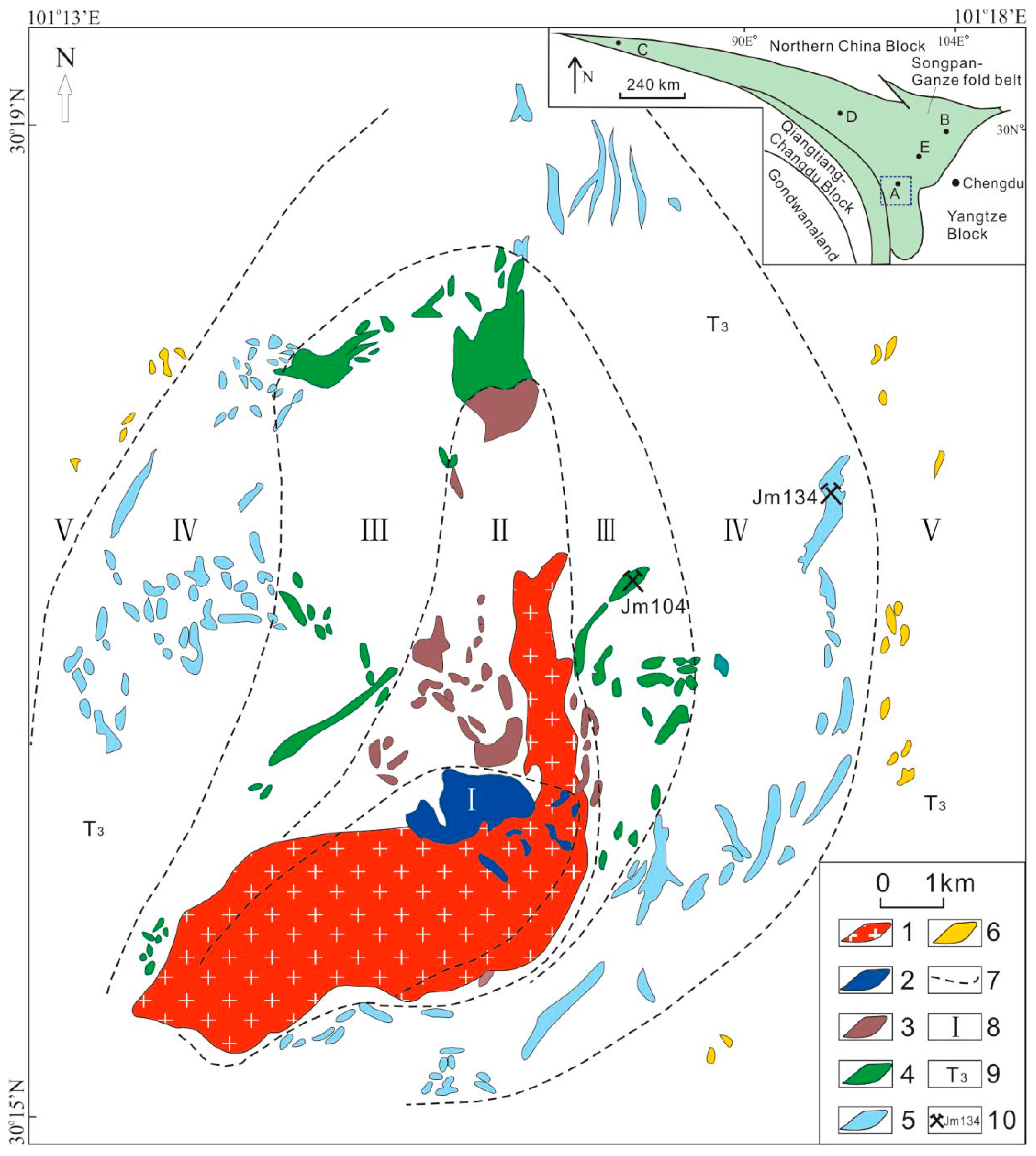
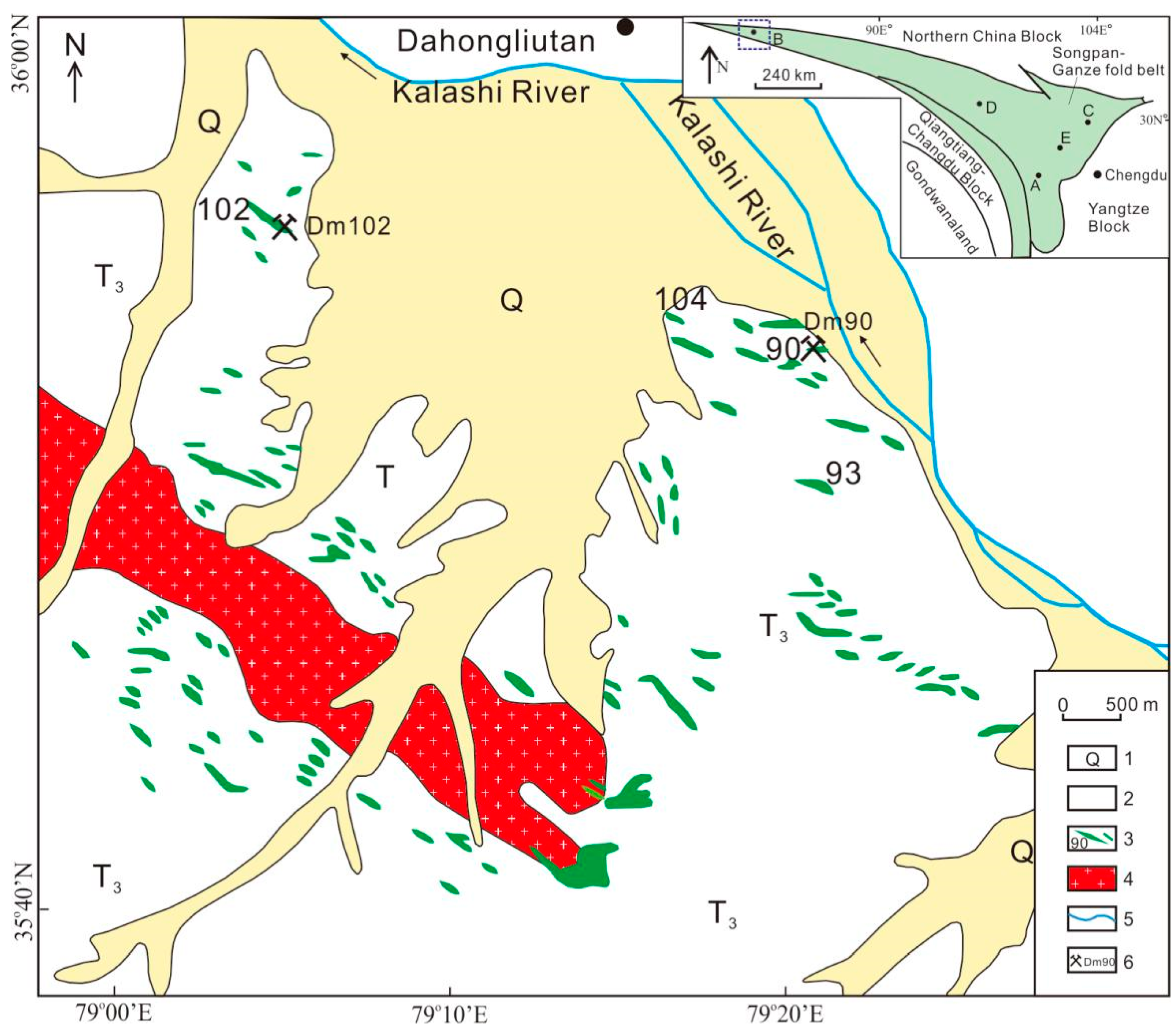
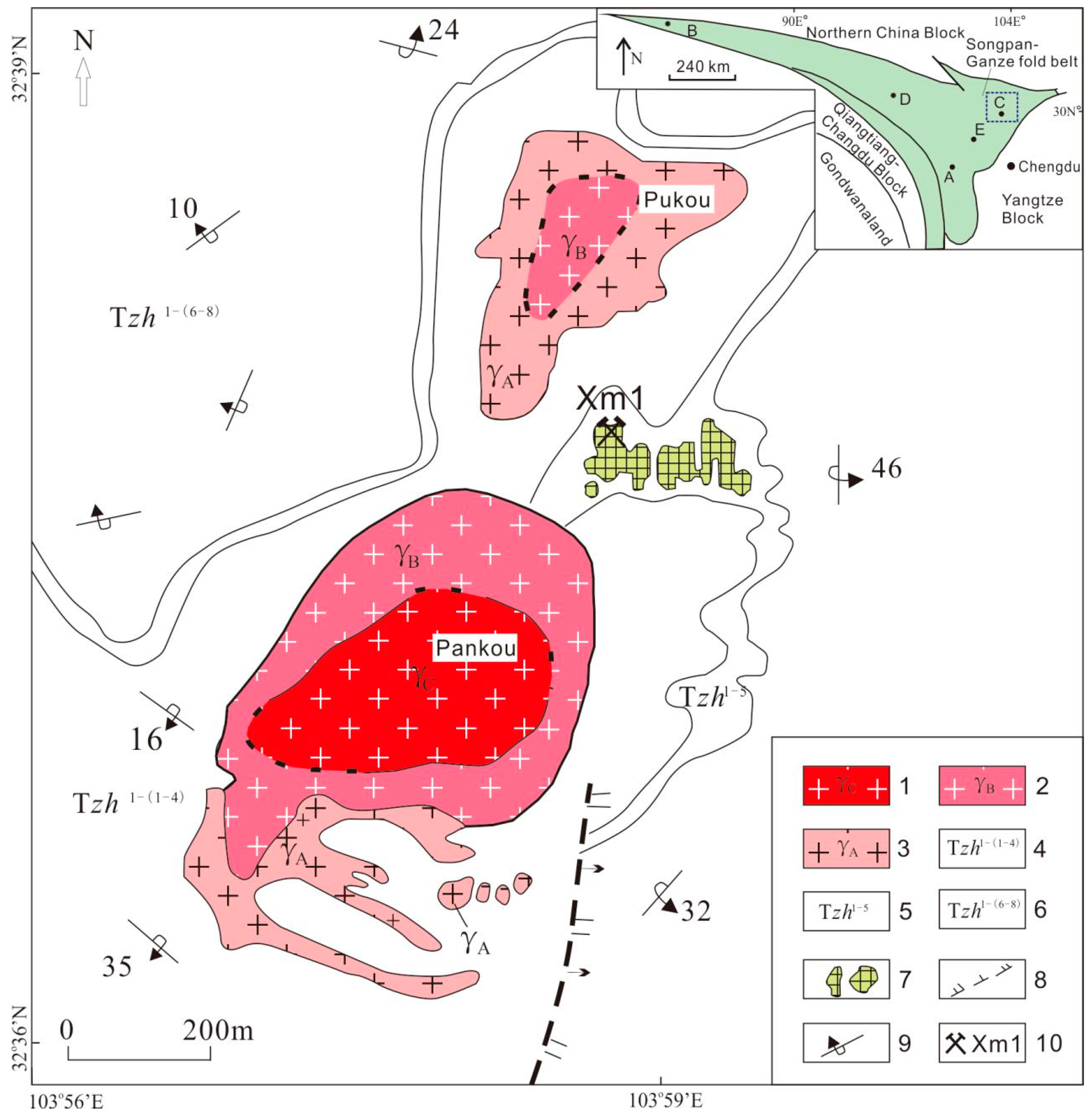
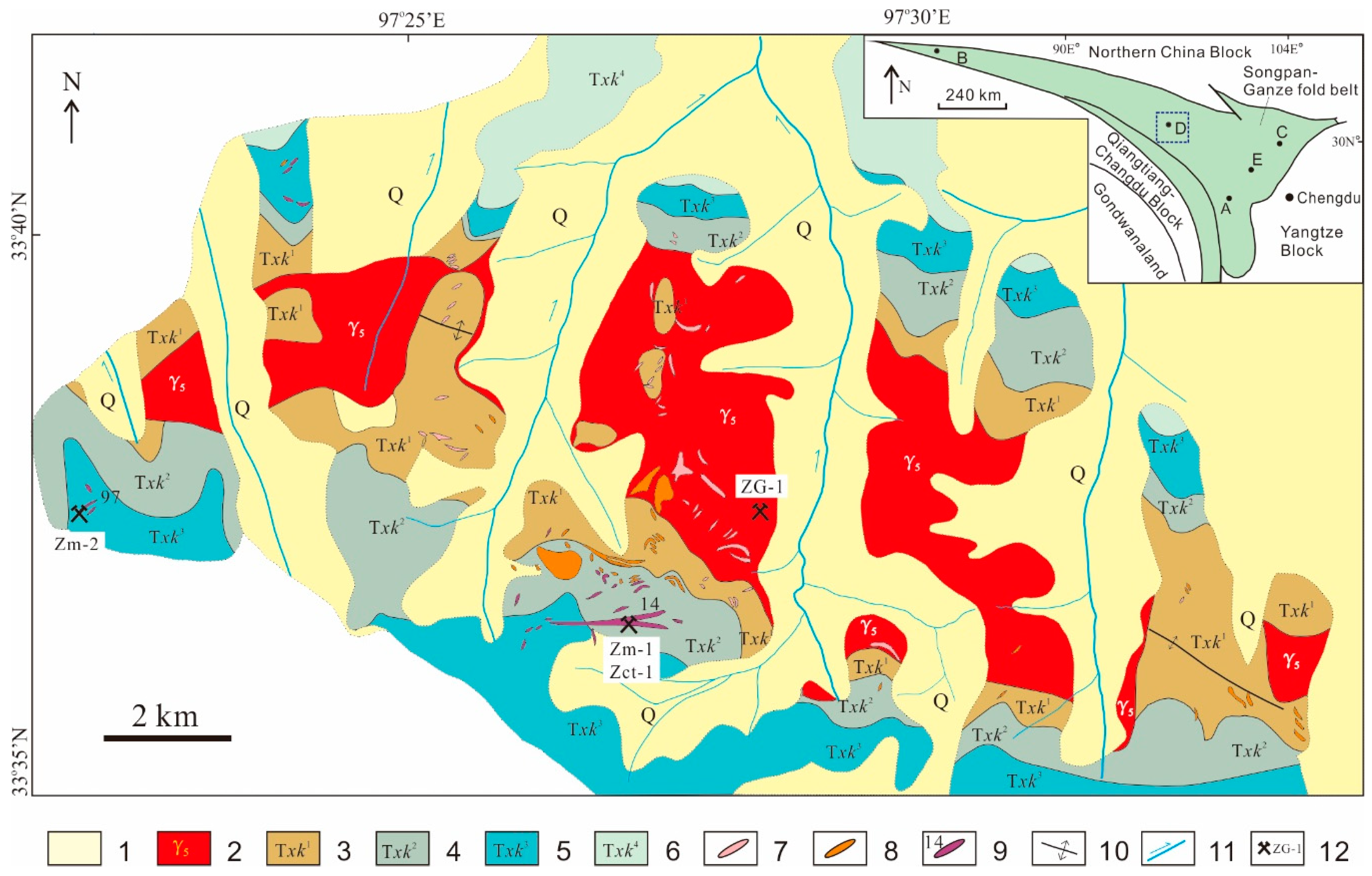
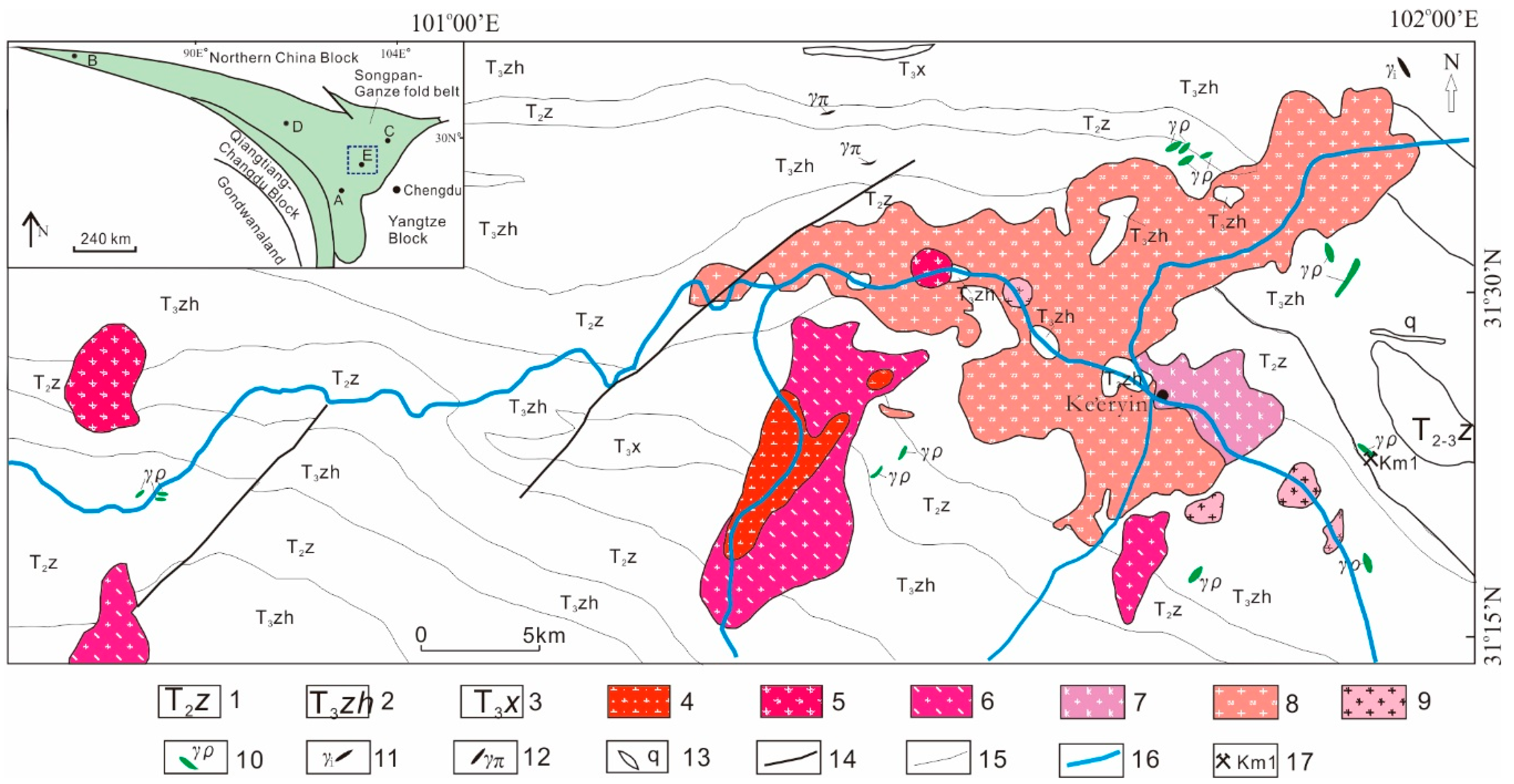
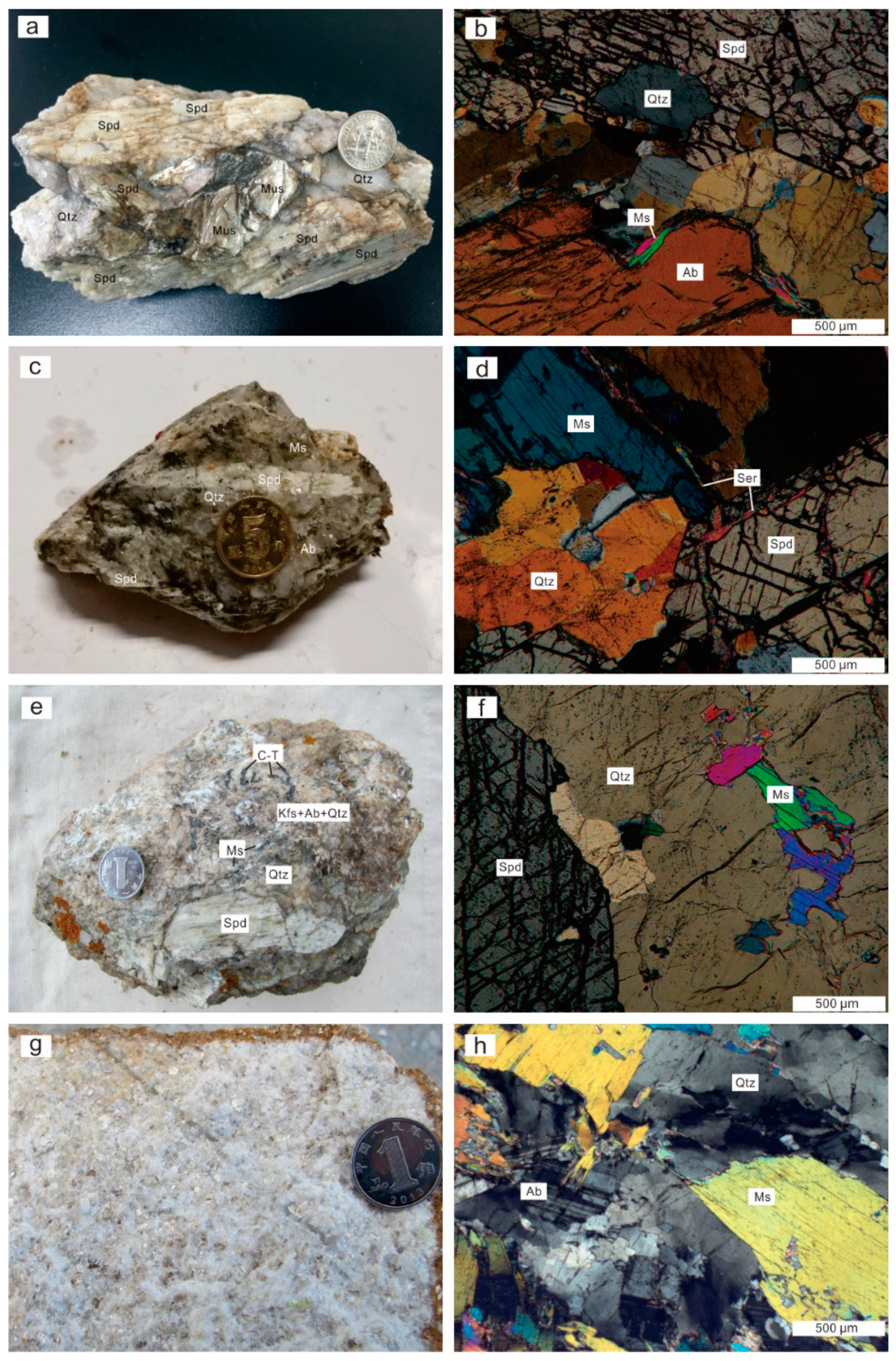
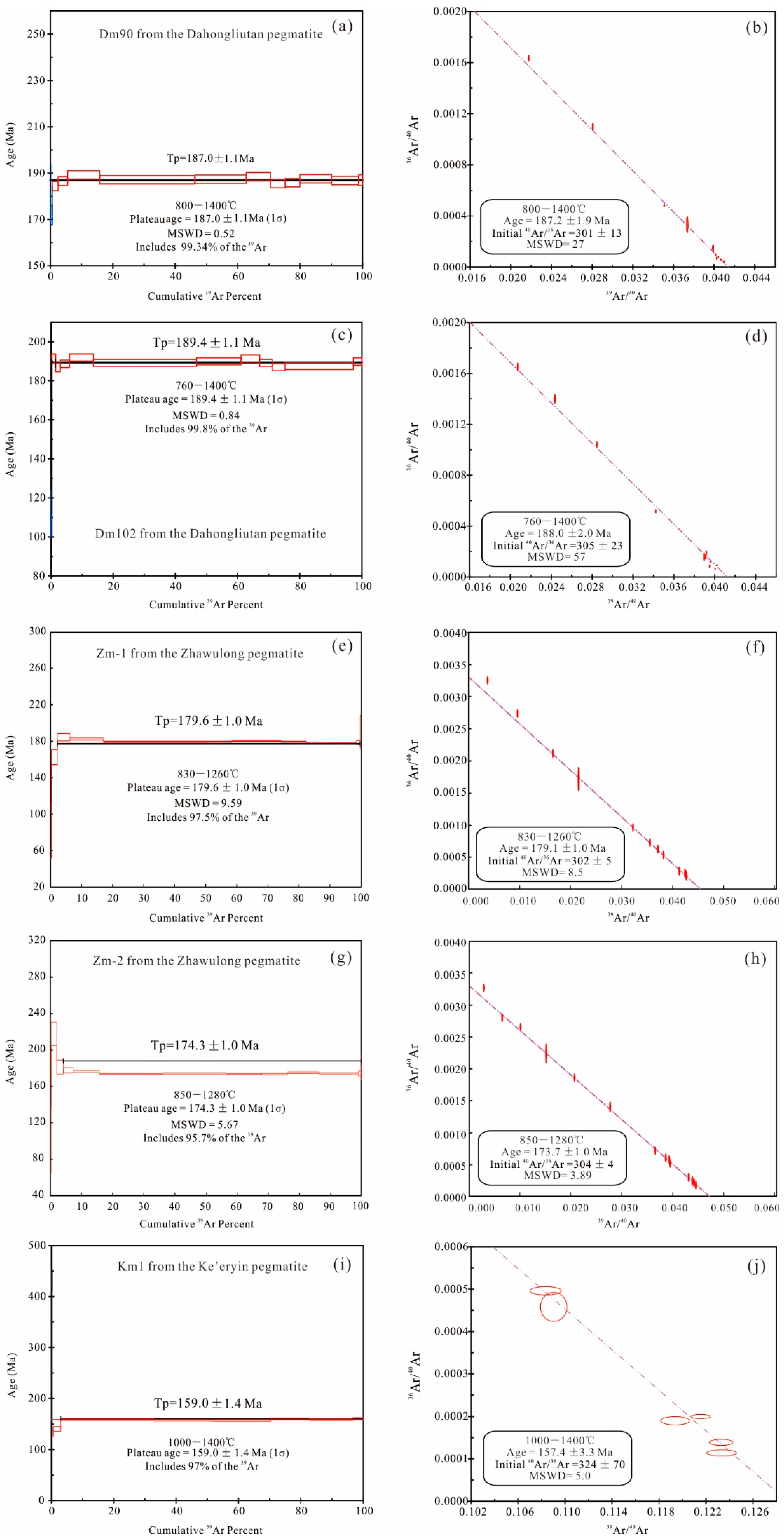
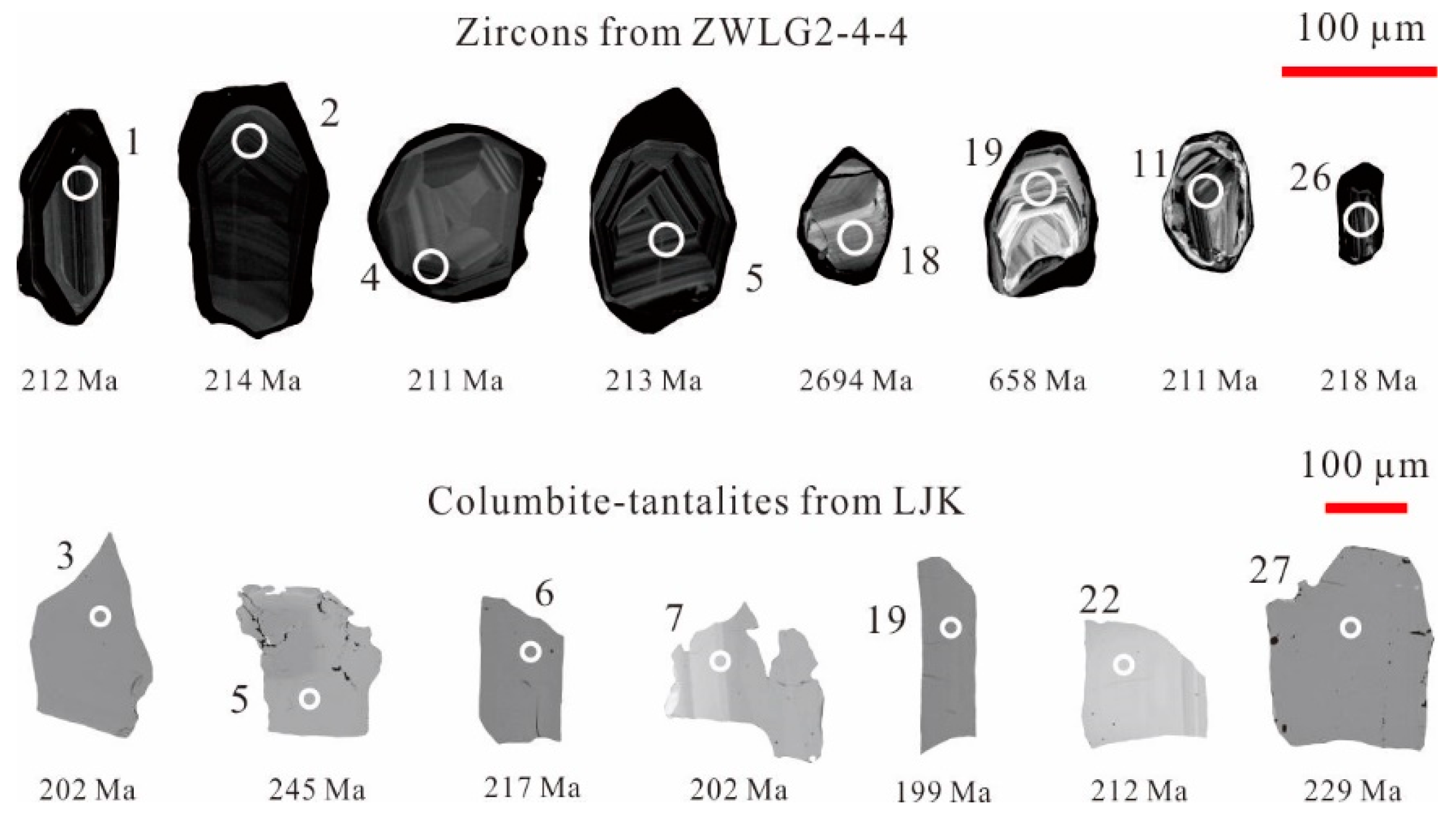
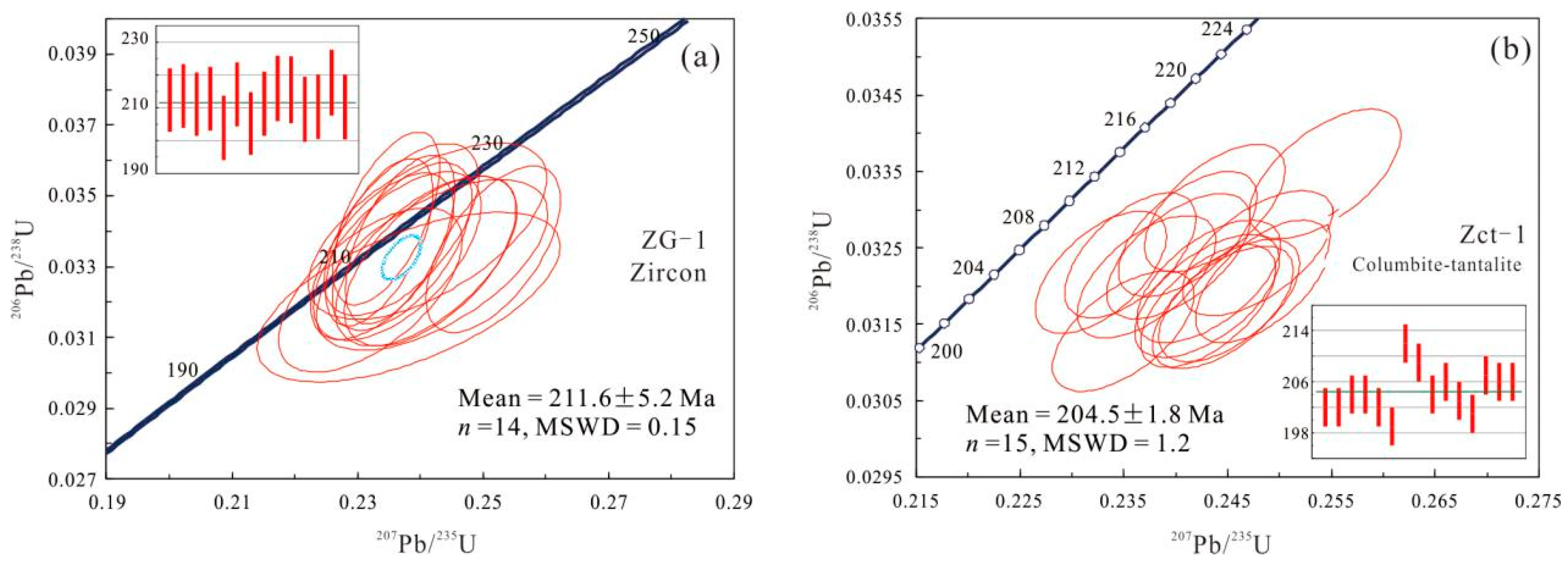
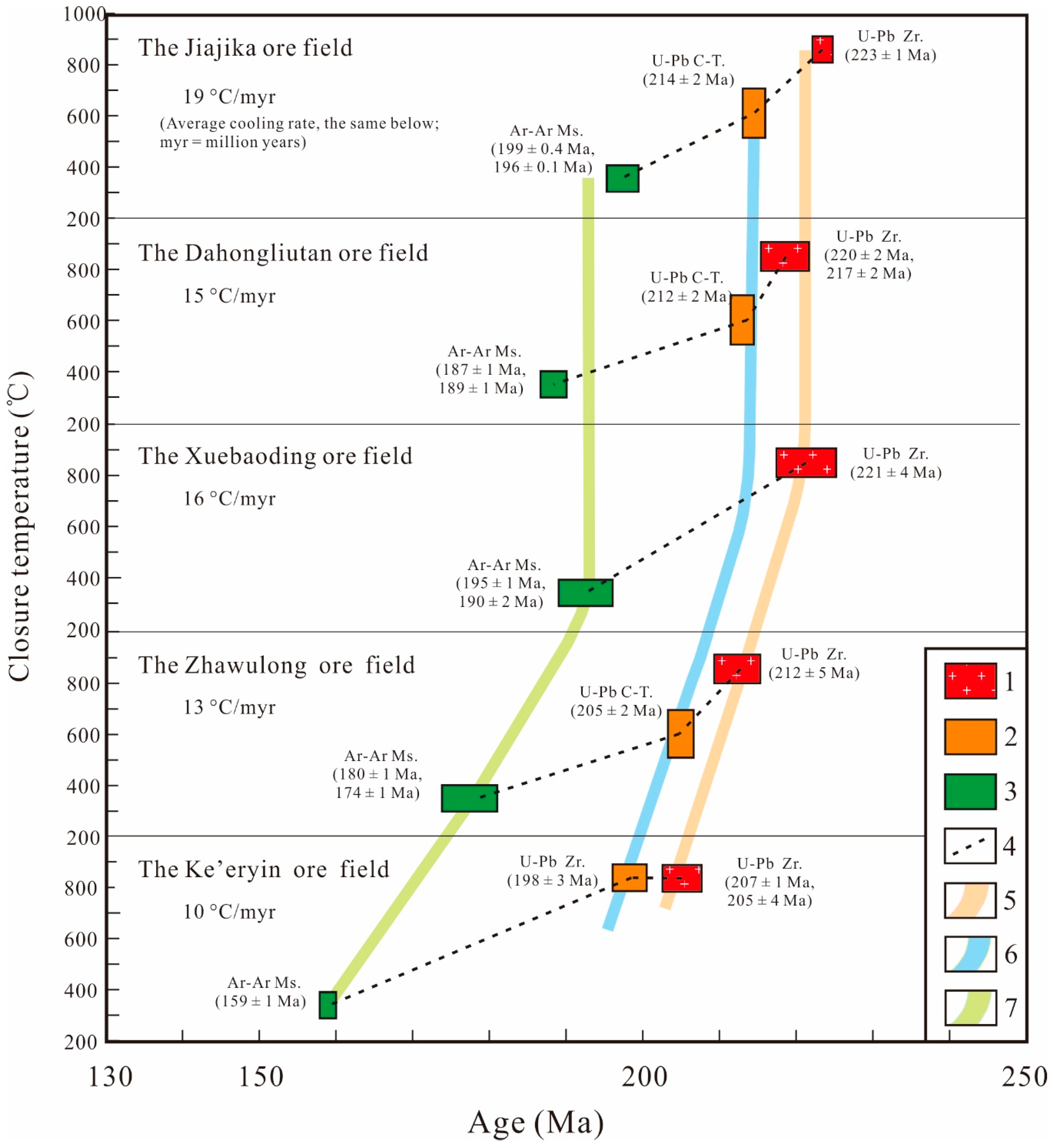
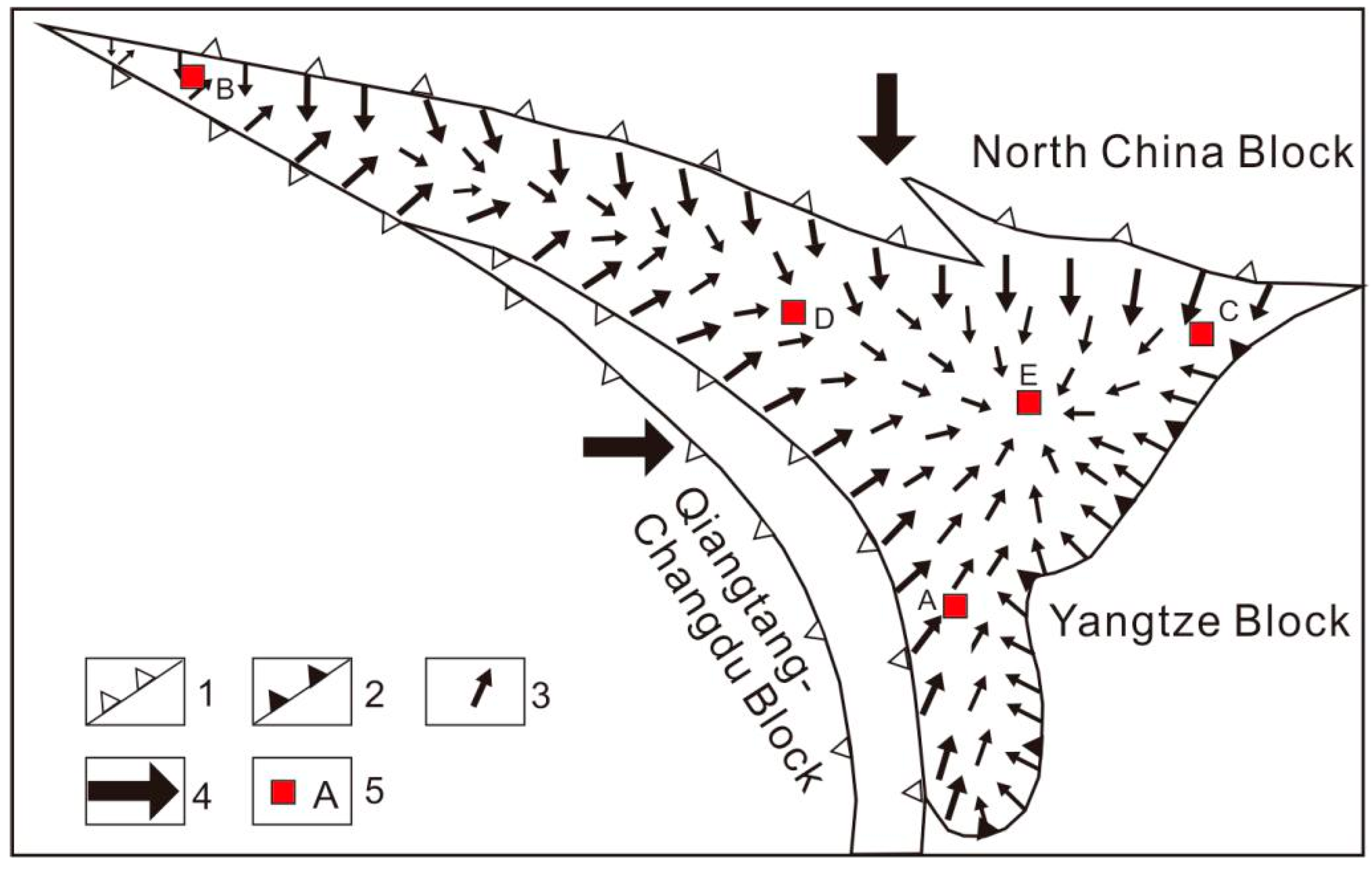
| Location | Sampling Locations (Muscovite Sample Number) | Dating Method | Age (Ma) | References |
|---|---|---|---|---|
| Jiajika ore field | Two-mica granite | Zircon U–Pb | 223 ± 1 | Hao et al. [16] |
| No. 3 spodumene pegmatite dike | Columbite–tantalite U-Pb | 214 ± 2 | Hao et al. [16] | |
| No.104 spodumene pegmatite dike (Jm104) | Muscovite Ar–Ar | 196 ± 0.1 | Wang et al. [17] | |
| No.134 pegmatite dike (Jm134) | Muscovite Ar–Ar | 199 ± 0.4 | Wang et al. [17] | |
| Xuebaoding ore field | Yanggonghai | Zircon U–Pb | 221 ± 4 | Zhang et al. [18] |
| Pegmatite dike (Xm1) | Muscovite Ar–Ar | 190 ± 2 | Li et al. [27] | |
| Pegmatite dike | Muscovite Ar–Ar | 195 ± 1 | Zhang et al. [19] | |
| Dahongliutan ore field | Two-mica granite | Zircon U–Pb | 220 ± 2 217 ± 2 | Qiao et al. [47] |
| The No. 90 pegmatite dike (Dm90) | Columbite U–Pb | 212 ± 2 | Yan et al. [48] | |
| Muscovite Ar–Ar | 189 ± 1 | This paper | ||
| The No. 102 pegmatite dike (Dm102) | Muscovite Ar–Ar | 187 ± 1 | This paper | |
| Zhawulong ore field | Muscovite granite (ZG-1) | Zircon U–Pb | 212 ± 5 | This paper |
| The No. 14 pegmatite dike (Zct-1) | Columbite–tantalite U–Pb | 205 ± 2 | This paper | |
| The No. 14 pegmatite dike (Zm-1) | Muscovite Ar–Ar | 180 ± 1 | This paper | |
| The No. 97 pegmatite dike (Zm-2) | Muscovite Ar–Ar | 174 ± 1 | This paper | |
| Ke’eryin ore field | Two-mica granite | Zircon U–Pb | 207 ± 1 205 ± 4 | Zhao et al. [49]; Yue et al. [50] |
| Lijiagou spodumene pegmatite dike | Zircon U–Pb | 198 ± 3 | Fei et al. [51] | |
| Muscovite pegmatite dike (Km1) | Muscovite Ar–Ar | 159 ± 1 | This paper |
© 2019 by the authors. Licensee MDPI, Basel, Switzerland. This article is an open access article distributed under the terms and conditions of the Creative Commons Attribution (CC BY) license (http://creativecommons.org/licenses/by/4.0/).
Share and Cite
Li, P.; Li, J.; Chou, I.-M.; Wang, D.; Xiong, X. Mineralization Epochs of Granitic Rare-Metal Pegmatite Deposits in the Songpan–Ganzê Orogenic Belt and Their Implications for Orogeny. Minerals 2019, 9, 280. https://doi.org/10.3390/min9050280
Li P, Li J, Chou I-M, Wang D, Xiong X. Mineralization Epochs of Granitic Rare-Metal Pegmatite Deposits in the Songpan–Ganzê Orogenic Belt and Their Implications for Orogeny. Minerals. 2019; 9(5):280. https://doi.org/10.3390/min9050280
Chicago/Turabian StyleLi, Peng, Jiankang Li, I-Ming Chou, Denghong Wang, and Xin Xiong. 2019. "Mineralization Epochs of Granitic Rare-Metal Pegmatite Deposits in the Songpan–Ganzê Orogenic Belt and Their Implications for Orogeny" Minerals 9, no. 5: 280. https://doi.org/10.3390/min9050280
APA StyleLi, P., Li, J., Chou, I.-M., Wang, D., & Xiong, X. (2019). Mineralization Epochs of Granitic Rare-Metal Pegmatite Deposits in the Songpan–Ganzê Orogenic Belt and Their Implications for Orogeny. Minerals, 9(5), 280. https://doi.org/10.3390/min9050280




